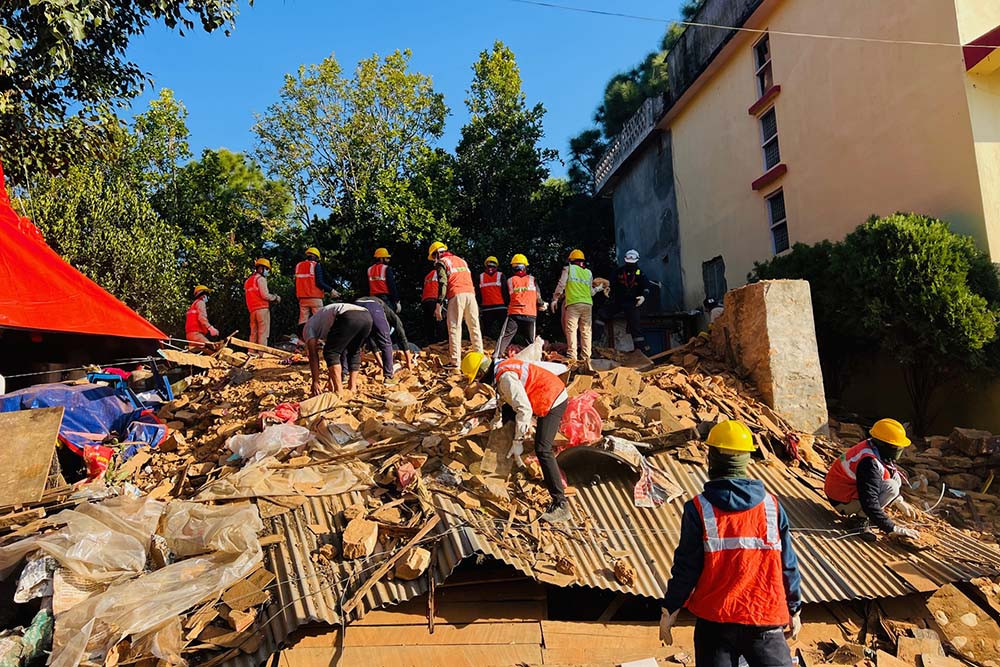
Despite the stress on the economy along with its slowdown, commercial banks have maintained sound profit in the first quarter (mid-July to mid-October) of 2023-24 with moderate impact. The profits made temperately shrunk to Rs 13.47 billion in the first quarter compared to Rs 18.75 billion in the corresponding period of the previous fiscal year.
However, the non-performing loans (NPL) of the 20 commercial banks in operation surpassed their Q1 profit. The average NPL of banks in the review period increased substantially from 1.77% of the first quarter of the previous fiscal to 3.40% as of the end of mid-October of this fiscal year. Considering the net loan portfolio of commercial banks worth Rs 4,399.51 billion, the amount of non-performing loans of commercial banks hovers at Rs 149.58 billion from Rs 74.66 billion in the corresponding period of the previous fiscal year.
Sunil KC, President of Nepal Bankers’ Association (NBA), said that the rising NPL is due to slackness in the economy. “We have to take the soaring NPL seriously. It has increased but is within a manageable level, yet we need to be cautious,” he said. KC further stated that the profit of the banks was affected as the provisioning amount expanded due to the non-performing loans. Banks have to allocate funds from their profit to cover the potential default on their loans.
However, the International Monetary Fund (IMF) has been consistently raising concerns on the asset quality of the banks. The capital adequacy ratio of banks is above the regulatory threshold, and the consistently high interest rates have deteriorated the loan repayment capacity of borrowers as a result of which the asset quality of banks is worsening, according to the IMF.
Finance Minister, Prakash Sharan Mahat, has urged Nepal Rastra Bank – the central regulatory and monetary authority – as well as banks and financial institutions (BFIs) to work on lowering non-performing loans stating that high NPL shrinks the loan mobilisation capacity of the BFIs, which could hit the desired growth target of the government in the near term and pose challenges to financial stability.
Seven banks in billionaire club in Q1
One-third of the commercial banks in operation made a lucrative profit of above a billion rupees in the first quarter of this fiscal. Nepal Investment Mega Bank topped the rank with total profit of Rs 1.52 billion followed by Nabil Bank (Rs 1.47 billion), Global IME Bank (Rs 1.23 billion), Prime Commercial Bank (Rs 1.15 billion), Himalayan Bank (Rs 1.06 billion), Prabhu Bank (Rs 1.03 billion) and NIC Asia Bank (Rs 1.01 billion), as per the unaudited financial statements disclosed by the banks. The interest rate of banks in the first quarter remained in the higher zone and most maintained a base rate in the double digit.
Banks at the bottom of the list in terms of profit were Agricultural Development Bank, Siddhartha Bank, Laxmi Sunrise Bank, Nepal Bank and Kumari Bank. Agricultural Development Bank was the only bank that faced a loss in the review period.
Ashoke Shumsher Rana, CEO of Himalayan Bank, stated that the availability of loanable funds has increased against the slumping loan demand which will drive banks to lower their interest rates. In the first quarter of this fiscal year, total loan mobilisation stood at Rs 115.23 billion against deposit collection of Rs 149.38 billion. “Banks have the appetite to expand credit,” said Rana, adding, “Hopefully, demand will be generated along with a downward revision in credit rates in the subsequent quarters.”
How will banks manage NPL?
Agricultural Development Bank has witnessed the highest level of NPL that stood at 5.33% of its total loan portfolio of Rs 187.10 billion. The soaring NPL has hit the bank’s earnings hard. The bank witnessed a loss of Rs 888 million in the first quarter of this fiscal year which posed manifold challenges to maintain other regulatory requirements. Kumari Bank, Nepal Investment Mega Bank, Laxmi Sunrise Bank, Himalayan Bank and Global IME Bank are others with high NPL.
The top five banks in terms of low NPL that is below the average of the banking sector are Everest Bank (0.9%), Standard Chartered Bank (1.10%), NIC Asia Bank (1.37%), Sanima Bank (1.79%) and Nepal SBI Bank (2.35%). Nara Bahadur Thapa, Former Executive Director of Nepal Rastra Bank, said that the current NPL considering the circumstances of Covid 19 pandemic and slowdown in the economy is not as alarming. “This will help banks to course correct. They will do some soul searching of the credit floated in the real estate, stock market and automobile sectors, among others,” said Thapa, adding “Given the scenario, banks will be more focused on the real sector of the economy, rather than creating a bubble by fuelling loans or concentrating their resources in a particular sector of the economy, which the central bank has been flagging since long.”
Financial sector analyst, Anal Raj Bhattarai, was of a similar opinion. He said, “Banks will be more cautious of asset quality considering the scenario. Loan-loss provisioning set aside by the banks in consideration to maintain the resilience will not push the banks into trouble. Once the economy gradually revives, the NPL will recover.”




